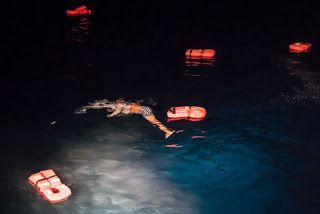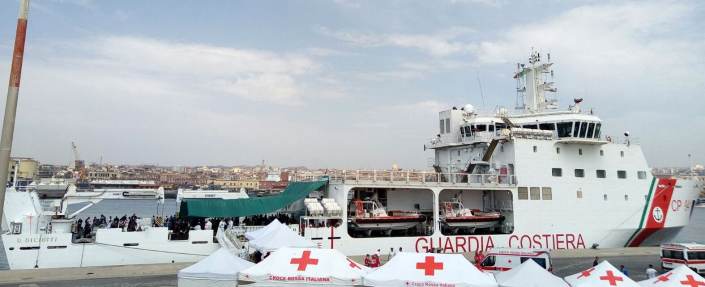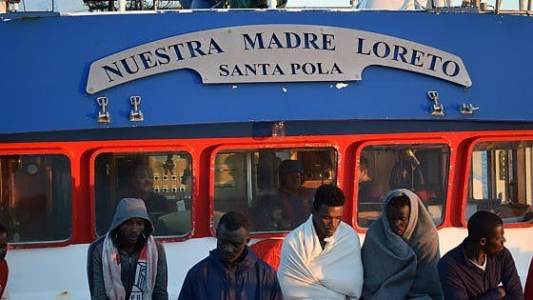Hell at Sea
On the night of October 21st, Noëmi Landolt found herself on board the Sea-Watch 2, a ship belonging to Sea-Watch, a German NGO, trying to save the 150 passengers of a dinghy in difficulty off the coast of Libya. The Libyan Coast Guard intervened, attacking the migrants and hitting them with sticks. Many ended up in the water and died. The following article, published in the newspaper WOZ (Die Wochenzeitung), tells her story of that terrible night.
Saturday, October 22nd, 6.53pm
In the last three days I have slept a total of four and a half hours. The living nightmare of the night with the Libyan Coast Guard now seems very distant, but I will never forget it. A little after midnight last Friday we received the order to intercept a migrant boat in distress with 150 people on board, 14.5 miles north of the Libyan coast and therefore outside Libyan waters. A tanker was nearby, but had no way of recovering the boat. A few days ago I wrote that there is nothing more desolate than a dinghy adrift. But then I had never seen a dinghy, full of migrants, adrift during the night.
At half past two we reach the boat. The lights from the tanker Okyroe twinkle in the dark night. As usual, we launch our two lifeboats to establish first contact with the migrants and distribute life jackets. The floodlights of our mother ship illuminate the migrant boat. All of a sudden, a Libyan Coast Guard patrol vessel appears. On the deck of the patrol vessel there are a dozen young soldiers, uniformed, partly armed and grim-faced – people you would rather not encounter in the dark. They are drawn up in rows like toy soldiers, each one in his place in a perfect tableau. Their appearance is simultaneously ridiculous and threatening. We can’t communicate with them; we speak no Arabic and they speak no English. Again and again they roar, “Go out!” But we do not know what they mean, but we have the impression that they want us to take the migrants and leave, get out, away from Libya.
But a moment later, with a dangerous manoeuvre, they push one of our lifeboats away from the migrants’ dinghy, one of their men jumps on board with a rope and starts beating the migrants and shouting abuse at them. We hear them screaming. Gripped by panic, four men throw themselves into the dark water. The crew of one of the lifeboats pulls them into the boat and takes them to the Sea-Watch 2. We help the four young men come aboard, trembling with fear or cold or perhaps both, seat them on the aft deck and wrap them in rescue blankets. I hear Ingo, our Head of Mission, shouting into his megaphone from the bows, “Boat is sinking! Men overboard! Men overboard!” I hear people screaming, but I don’t want to look and I stay with the four young men. I am taking them two cups of tea; the screaming is filling my ears; anyway I don’t know where the teacups ended up, because suddenly I’m helping to pull a young man on board, completely drenched and half naked. I would like to help him pull up his trousers, but hell has already broken loose. More and more wet bodies are falling next to me, screaming, whimpering, shaking on the deck. I rush to the rail and together with the others start to throw countless lifejackets overboard. But I’m against the wind and they never land where I want them to. Cables, lifebelts – we throw everything we can into the water. Eventually the sinking boat is so close that we can grab their hands. A lanky boy close to me, just climbed aboard himself, pulls one after another on board with an incredible strength. I reach for hands, legs, trousers, wet arms that slip away from me then suddenly grip, and another is up.
I cannot remember that I saw anyone drown that night. That can hardly be: between twenty and thirty people did drown. Your mind plays tricks on you. I can remember that in the sinking boat two bodies lay, face-down and stripped from the waist. I can remember the tall, powerful man, who stood in the boat with his arms hanging by his sides, mutely, looting up at us with wide eyes as the boat sank. Somehow we got him by the hands and pulled him on deck. Many of those who boarded immediately tore off their clothes, because the mixture of petrol and seawater was burning their skin. Our two lifeboats scoured the surrounding area taking other people out of the water, including four dead. The Sea-Watch crew was able to save 124 people that night.
I do not know how long it took to get everyone on board. We give out rescue blankets and bottles of water, use hoses to wash the corrosive petrol from their bodies. Some of the migrants help us, many fall straight to sleep, lulled by the rustling of the foil rescue blankets in the wind. We sail north. When it gets light, we realise that most of our guests are very young. Young men of about twenty, some even younger, maybe only twelve or fourteen. Very few have reached thirty.
At seven o’clock we meet a wooden boat with fourteen other men on board. From Libya and Syria, they come on board without even wetting their feet and with backpacks and suitcases on wheels. We head towards the tanker Okyroe to transfer the migrants we have saved onboard. During the morning other dinghies full of migrants appear: we count eight with a load of 150 people for each boat. Our lifeboats are constantly on the water, distributing life jackets to the migrants, shuttling them to the tanker, where they must climb a rope ladder more than 25 metres long to get aboard. We on the Sea-Watch 2 try to give our guests the essentials, sorting lifejackets and helping other people get on board. Gradually the ship fills up. There are now at least 200 people on board. Among them a handful of completely exhausted women, one of them alone with her two small children, who fall asleep as soon as they arrive on deck. At sunset, the last five leave our ship and board the tanker, after taking their leave of their dead brother, who was laid out in the Medic Room.
We clean up the worst of the chaos. At some point a speed boat arrives from the Sien Pilot (a Norwegian ship belonging to the Frontex mission) carrying men in white full-body suits. They look to me like extraterrestrials. They take away the four dead. A speed boat from a Spanish warship orders us to sink the migrants’ boat. We try to clean up and decide to head as far north as possible, that is, to get out of the 24-mile zone to have at least a half day of rest and to sort out our equipment. At half past eleven I finally go to bed. Three hours later we are all woken again. Again we hear cries in the darkness, again we catch sight of a dinghy with 150 people on board. Among them are many women and children. The rescue runs smoothly, but even as we deal with this boat, others appear on the horizon: seven, eight, ten, twelve… it does not stop. More than 3000 people drift on the open sea. The MSF (Médecins Sans Frontières) vessel Dignity, the Nowegian Sien Pilot, and again the tanker Okyroe – which in fact was en route to Thailand – take part in the rescue. Our lifeboats collect the scattered passengers of four large dinghies and one small one. Between them move “engine fishers” (motorised fishing boats), speedboats and helicopters.
Towards evening the Italian Coast Guard arrives and evacuates all the boats which had gathered around us. The days and their events are muddled in my head. What was yesterday? What was today? As a child I had a small Nintendo with a simple 8-bit game, in which you had to catch skydivers in a little rowing boat. More and more of them fall, faster and faster, until too many fall in the water. Game over. It seems to me that we too are playing a big, perverse game, in a huge arena of water, in the middle of which floats a large tanker and from every corner of which new players emerge. But what are we playing at?
Noëmi Landolt
Translated from German to Italian by A. Monteggia
Translated from Italian to English by Amica Sciortino Nowlan






